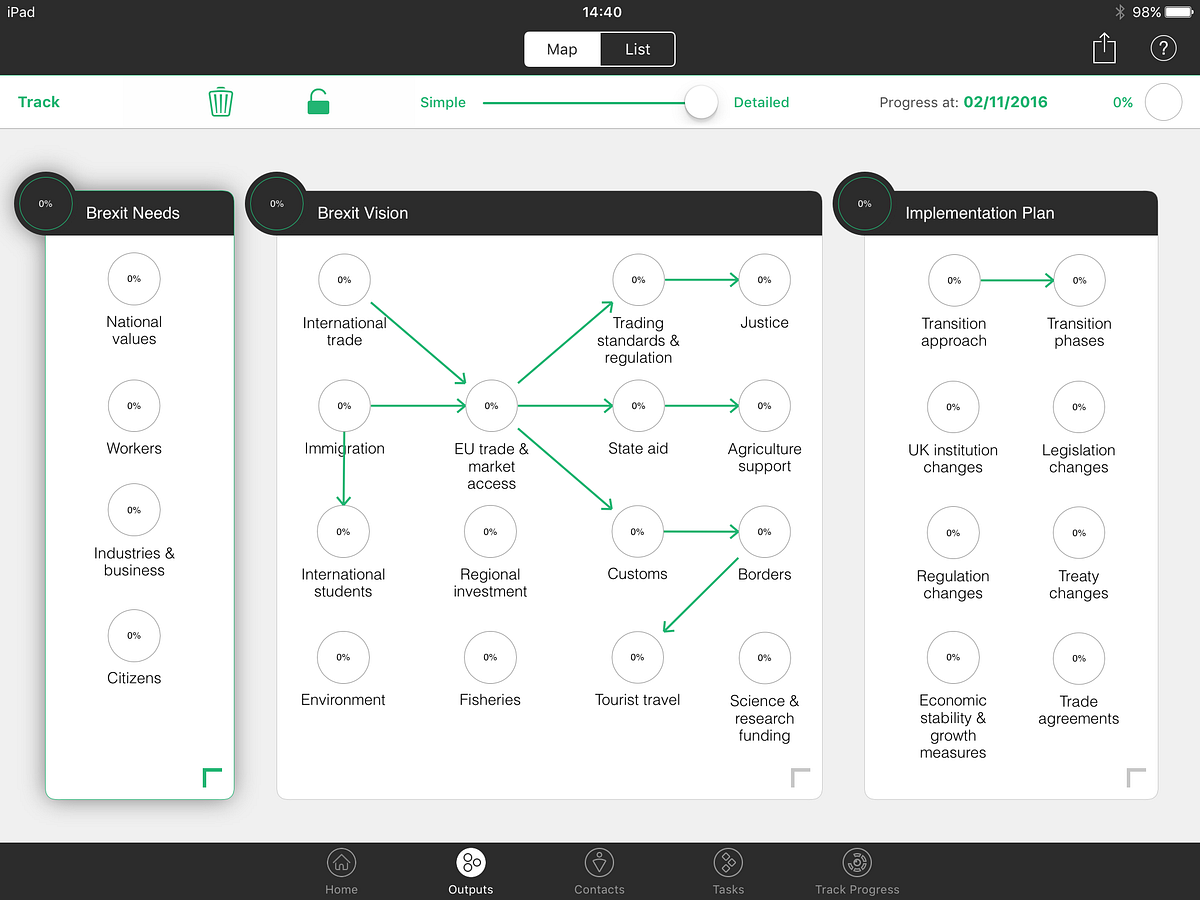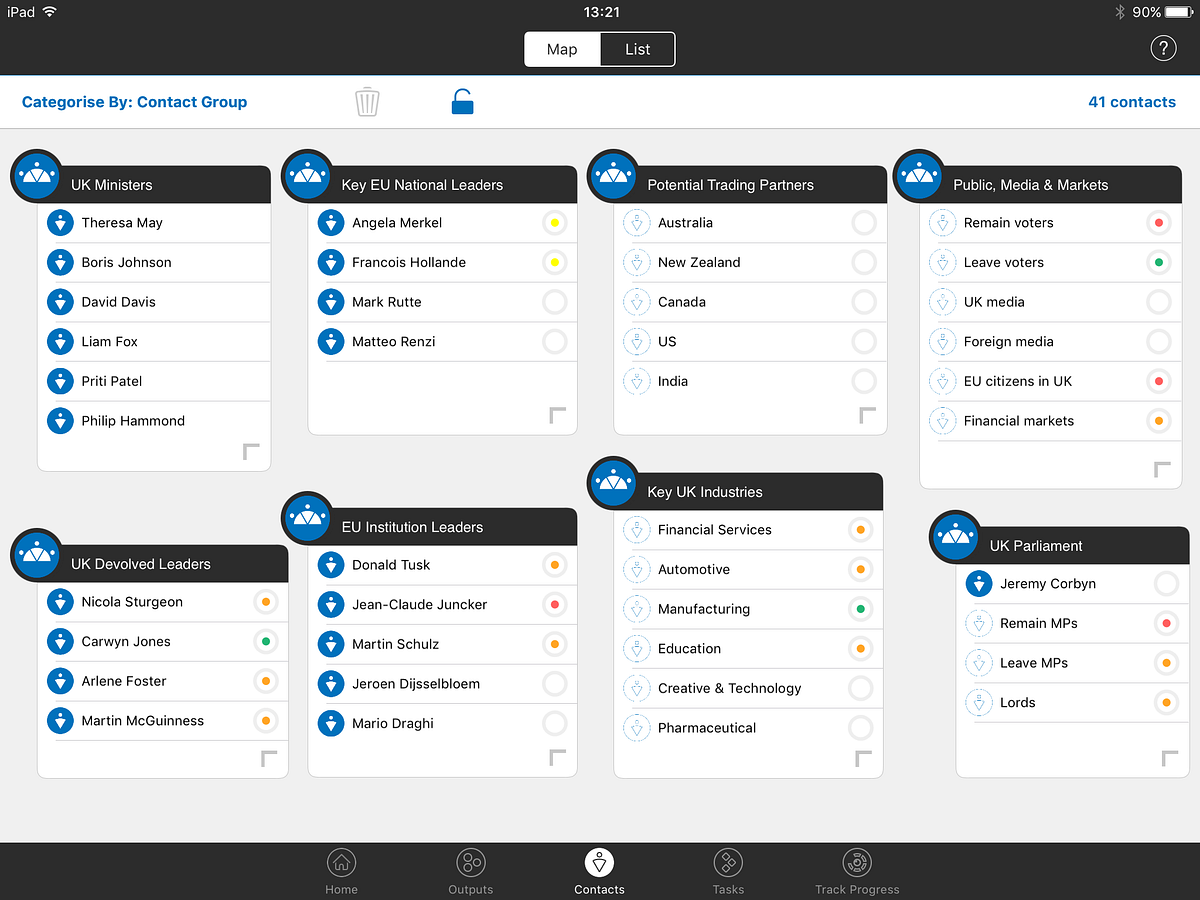Dan Onions offers an eleven-step decision plan based on his DASH method, showing the interrelated decisions to be taken on Brexit as a DASH output map.
 | |
| A decision plan for Brexit (Dan Onions) |
 |
| A stakeholder map for Brexit (Dan Onions) |
Let me now contrast Dan's approach with Simon Wardley's. Simon had been making a general point about strategy and execution on Twitter.
Knowing Simon's views on Brexit, I asked whether he would apply the same principle to the UK Government's project to exit the European Union.In 25 years in business, I've never seen a problem caused by "poor execution". It is always crap strategy looking for someone else to blame.— swardley (@swardley) April 29, 2016
ah @richardveryard #Brexit could be an opportunity, it depends upon steps taken. Alas, in complex environments it can't be pre-determined.— swardley (@swardley) November 8, 2016
which goes back to first rule of strategy @richardveryard. it's iterative. You consider as much as you can and adapt as you play the game.— swardley (@swardley) November 8, 2016
It's best summed up for me @richardveryard in this diagram pic.twitter.com/k8j8yciXsa— swardley (@swardley) November 8, 2016
@swardley Nice picture. So how do you address strategic governance, given that #Brexit was supposedly about sovereignty and control.— Richard Veryard (@richardveryard) November 8, 2016
@richardveryard : structure / governance is under doctrine (e.g. small autonomous teams, use appropriate methods, remove bias & duplication)— swardley (@swardley) November 8, 2016
@richardveryard : whereas choice / decision / direction is under leadership.— swardley (@swardley) November 8, 2016
@swardley You are answering in abstractions. How do you answer the concrete questions of sovereignty and control in relation to #Brexit?— Richard Veryard (@richardveryard) November 8, 2016
Simon's diagram revolves around purpose. OODA is a single loop, and the purpose is typically unproblematic. This reflects the UK government's perspective on Brexit, in which the purpose is assumed to be simply realising the Will of the People. The Prime Minister regards all interpretation, choice, decision and direction as falling under her control as leader. And according to the Prime Minister's doctrine, attempts by other stakeholders (such as Parliament or the Judiciary) to exert any governance over the process is tantamount to frustrating the Will of the People.
Whereas Dan's notion is explicitly pluralist - trying to negotiate something acceptable to a broad range of stakeholders with different concerns. He characterizes the challenge as complex and nebulous. Even this characterization would be regarded as subversive by orthodox Brexiteers. It is depressing to compare Dan's careful planning with Government insouciance.
Elsewhere, Simon has acknowledged that "acting upon your strategic choices (the why of movement) can also ultimately change your goal (the why of purpose)". Many years ago, I wrote something on what I called Third-Order Requirements Engineering, which suggested that changing the requirements goal led to a change in identity - if your beliefs and desires have changed, then in a sense you also have changed. This is a subtlety that is lost on most conventional stakeholder management approaches. It will be fascinating to see how the Brexit constituency (or for that matter the Trump constituency) evolves over time, especially as they discover the truth of George Bernard Shaw's remark.
"There are two tragedies in life. One is to lose your heart's desire. The other is to gain it."
Dan Onions, An 11 step Decision Plan for Brexit (6 November 2016)
Richard Veryard, Third Order Requirements Engineering (SlideShare)
Based on R.A. Veryard and J.E. Dobson, 'Third Order Requirements Engineering: Vision and Identity', in Proceedings of REFSQ 95, Second International Workshop on Requirements Engineering, (Jyvaskyla, Finland: June 12-13, 1995)
Simon Wardley, On Being Lost (August 2016)
Related Posts: VPEC-T and Pluralism (June 2010)
Interesting and well written post Richard. I'd love to know more about your "third order requirements" approach.
ReplyDelete